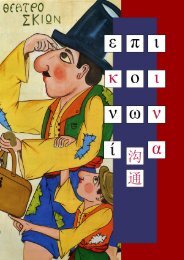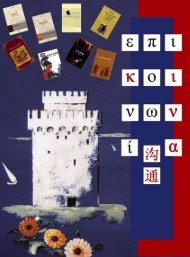Fifth Issue
Fifth Issue
Fifth Issue
You also want an ePaper? Increase the reach of your titles
YUMPU automatically turns print PDFs into web optimized ePapers that Google loves.
qualities and attributes of the characters, new styles of language, of clothing, new means<br />
of transportation, a different cultural context.<br />
Furthermore, Greek artists experiment with new forms of Karagiozis’ visual<br />
presentation. Karagiozis is not anymore a shadow figure on a screen. He becomes, along<br />
with all the characters, a person on the stage of the theater, and the aesthetic perception of<br />
Shadow Theater acquires a new perspective and a new form of expression.<br />
In 1972, the performance “Our<br />
Great Circus” capitalizes on the acting<br />
skills of a genuine folk Greek actor,<br />
Dionysis Papagiannopoulos, who gives life<br />
to the hero of the Shadow Theater and<br />
makes him a symbol of satire, a symbol of Greek identity.<br />
In 1951, Greek Choreographer, Rallou Manou,<br />
presents with her troupe “Greek Chorodrama”, a<br />
legendary performance of the play “Alexander the Great<br />
and the cursed snake”.<br />
How would the world be without light and shadow? How would the world be<br />
without colors, jokes and puns? I don’t know. I can only think of Karagiozis vibrant<br />
laughter, of his vivid imagination, that transforms his universe to a new reality, and then<br />
I know that his colorful jokes are the light and the shadow of the stage. I know that this is<br />
living!<br />
Eleni P. Moutsaki<br />
Embassy of Greece in Beijing<br />
Press & Communication Office<br />
38






